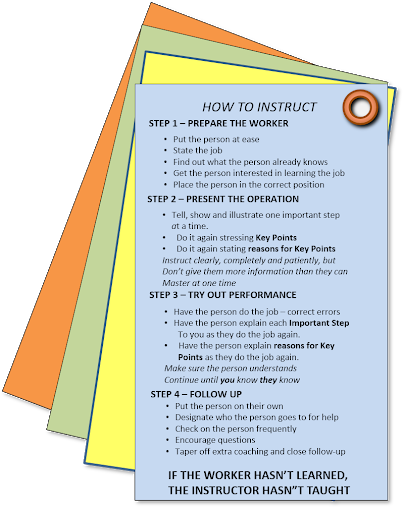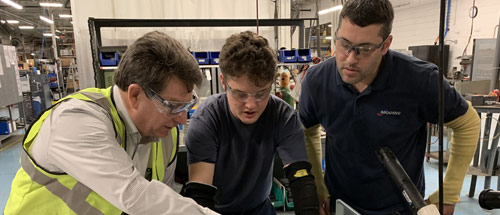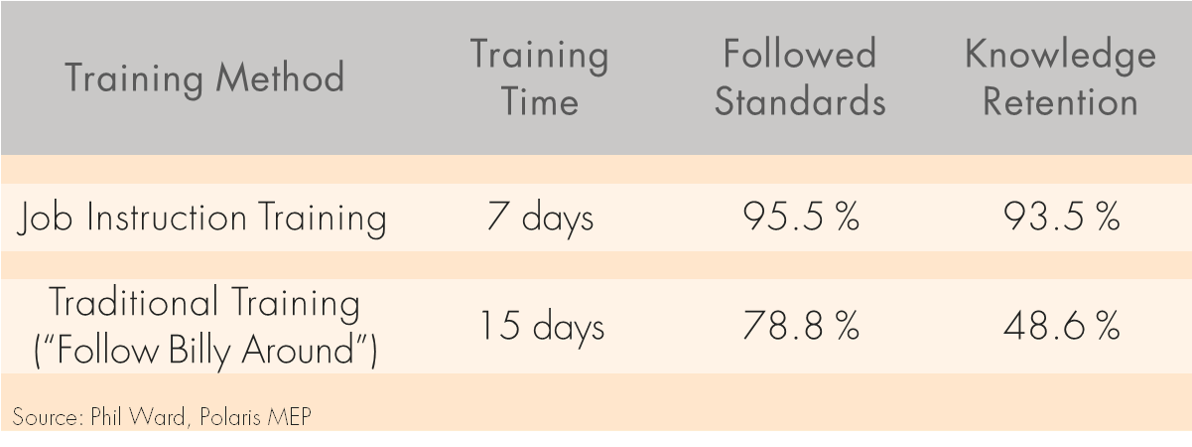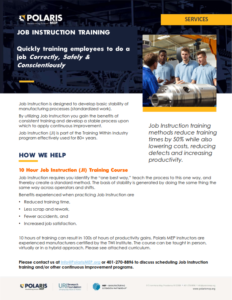In my last post, I told the story of stumbling across a methodology called
Training Within Industry (TWI) which routinely showed 25 – 50% reductions in manufacturing training times when the Job Instruction method was implemented.

I knew that if I could achieve these results at my company, it would be a breakthrough. I became certified as a Job Instruction Trainer so that I could teach the training methodology myself and spent the next 10 years implementing this methodology into the factory I worked at and across the larger organization with great results
After training successes in different pilot situations, I wanted to do an “apples to apples” comparison between the
Job Instruction training methodology and the “
Follow Billy Around” method (as I lovingly called it) that we were currently using at our factory.
Most manufacturers in Rhode Island and beyond can relate to “Follow Billy Around.” This is where a new employee is assigned to an “expert” until the expert says the worker is ready to go on their own.
While we all love Billy, is this traditional training approach the best one? I set up an experiment in a production environment that would collect hard data on these two methods of training.
Designing A TWI Job Instruction Experiment

Our team picked the most important, “bottleneck” area in the manufacturing plant to run our training experiment.
We would train a Level 1 Operations Certification. We started by pulling the records of the past 15 employees that had been trained in this area.
We found a lot of variability in the training times ranging from 15 days to 35 days. The average was 24 days, but since about half had completed their training in 15 days, we used 15 days as our benchmark baseline training time.
In designing the experiment, the criteria we established included:
- One trainer would use the Job Instruction Method and a one trainer would use the traditional method (no, that trainer was not named Billy)
- Both trainers would be required to run full production while training
- Each Trainer/Trainee pair would be responsible to run 3 machines during their shift
- Trainees would not be familiar with the process or the machine that they would be trained on
- There was no deadline for training
- Four weeks after completion of the training, a third party would audit each trainee for adherence to the standard work and knowledge retention
Once both trainers had completed their training and certified the trainees at the Level 1 Operation, we waited 4 weeks then sent in our auditors. The third-party auditors observed the trainees running their equipment and used the Job Breakdown Sheets for information to ask questions to test their knowledge.
We were looking for results in three areas:
- What was the total training time to certification?
- Does the Trainee do the work in the order that they were taught? Do they follow the standard operational procedure?
- What level of knowledge have they retained? Do they understand the work that they are doing?
Impressive Results With Job Instruction Training Methodology

With the Job Instruction Training Methodology;
- Training Time was cut by more than 50%, from 15 days to 7 days
- Adherence to the Standard improved by 17.5% from 78.8% to 95.5%
- Knowledge Retention increased by 48%, from 48.6% to 93.5%.
The team got some key learnings from running this experiment.
Not only did we learn that the training times could be drastically reduced, but that the people really understood the work that they were doing. Most importantly Trainees now knew
WHY they were doing the work in a specific way.
We also learned that with the traditional training method — where there was no training standard documentation like the Job Breakdown Sheet in Job Instruction –, trainers would forget to teach certain tasks. This was because they were training from memory and experience ONLY. Because they are human, the trainers sometimes forgot or overlooked certain things.
Reduced Training Times, Improved Quality AND Lower Turnover
In summary,
- We had new manufacturing employees that became productive in half the time, which our supervisors loved.
- Because of the Trainees’ now-high level of knowledge, we also had very conscientious employees.
- This reduced our process variation, which improved our product quality.
All three of these benefits saved the company a lot of money in the long run.
Perhaps even more importantly the employees that were trained using Job Instruction really appreciated the level of quality training that they received. These workers felt very confident from the beginning when doing their jobs.

Trainees also felt respected, because of the dedicated, personal one-on-one training and the time spent on them as individuals to ensure that they were successful. This advantage helped us retain employees.
In this high-tech age with modern, expensive, high-tech, virtual reality, computer-based* training opportunities, Job Instruction might seem simple and old fashioned, but it works.
Click here to read Part 1: Stop Chasing The Latest Training Fad.
Are you ready to stop following Billy and start down a path towards real results? Let’s talk about designing a pilot like the one above to prove that TWI Job Instruction can
improve training outcomes at YOUR manufacturing company. Email us at
info@polarismep.org.
* As the COVID-19 pandemic has led to visitor restrictions at many manufacturing companies, we now offer Job Instruction Training in-person, completely virtually or as a hybrid course. Click here to learn more about the curriculum and delivery.
——
About the Author: Phil Ward served Rhode Island manufacturers as a Project Manager from 2018 to 2021.  I knew that if I could achieve these results at my company, it would be a breakthrough. I became certified as a Job Instruction Trainer so that I could teach the training methodology myself and spent the next 10 years implementing this methodology into the factory I worked at and across the larger organization with great results
After training successes in different pilot situations, I wanted to do an “apples to apples” comparison between the Job Instruction training methodology and the “Follow Billy Around” method (as I lovingly called it) that we were currently using at our factory.
Most manufacturers in Rhode Island and beyond can relate to “Follow Billy Around.” This is where a new employee is assigned to an “expert” until the expert says the worker is ready to go on their own.
While we all love Billy, is this traditional training approach the best one? I set up an experiment in a production environment that would collect hard data on these two methods of training.
I knew that if I could achieve these results at my company, it would be a breakthrough. I became certified as a Job Instruction Trainer so that I could teach the training methodology myself and spent the next 10 years implementing this methodology into the factory I worked at and across the larger organization with great results
After training successes in different pilot situations, I wanted to do an “apples to apples” comparison between the Job Instruction training methodology and the “Follow Billy Around” method (as I lovingly called it) that we were currently using at our factory.
Most manufacturers in Rhode Island and beyond can relate to “Follow Billy Around.” This is where a new employee is assigned to an “expert” until the expert says the worker is ready to go on their own.
While we all love Billy, is this traditional training approach the best one? I set up an experiment in a production environment that would collect hard data on these two methods of training.
 Our team picked the most important, “bottleneck” area in the manufacturing plant to run our training experiment.
We would train a Level 1 Operations Certification. We started by pulling the records of the past 15 employees that had been trained in this area.
We found a lot of variability in the training times ranging from 15 days to 35 days. The average was 24 days, but since about half had completed their training in 15 days, we used 15 days as our benchmark baseline training time.
In designing the experiment, the criteria we established included:
Our team picked the most important, “bottleneck” area in the manufacturing plant to run our training experiment.
We would train a Level 1 Operations Certification. We started by pulling the records of the past 15 employees that had been trained in this area.
We found a lot of variability in the training times ranging from 15 days to 35 days. The average was 24 days, but since about half had completed their training in 15 days, we used 15 days as our benchmark baseline training time.
In designing the experiment, the criteria we established included:
 With the Job Instruction Training Methodology;
With the Job Instruction Training Methodology;
 Trainees also felt respected, because of the dedicated, personal one-on-one training and the time spent on them as individuals to ensure that they were successful. This advantage helped us retain employees.
In this high-tech age with modern, expensive, high-tech, virtual reality, computer-based* training opportunities, Job Instruction might seem simple and old fashioned, but it works.
Click here to read Part 1: Stop Chasing The Latest Training Fad.
Are you ready to stop following Billy and start down a path towards real results? Let’s talk about designing a pilot like the one above to prove that TWI Job Instruction can improve training outcomes at YOUR manufacturing company. Email us at info@polarismep.org.
* As the COVID-19 pandemic has led to visitor restrictions at many manufacturing companies, we now offer Job Instruction Training in-person, completely virtually or as a hybrid course. Click here to learn more about the curriculum and delivery.
——
About the Author: Phil Ward served Rhode Island manufacturers as a Project Manager from 2018 to 2021.
Trainees also felt respected, because of the dedicated, personal one-on-one training and the time spent on them as individuals to ensure that they were successful. This advantage helped us retain employees.
In this high-tech age with modern, expensive, high-tech, virtual reality, computer-based* training opportunities, Job Instruction might seem simple and old fashioned, but it works.
Click here to read Part 1: Stop Chasing The Latest Training Fad.
Are you ready to stop following Billy and start down a path towards real results? Let’s talk about designing a pilot like the one above to prove that TWI Job Instruction can improve training outcomes at YOUR manufacturing company. Email us at info@polarismep.org.
* As the COVID-19 pandemic has led to visitor restrictions at many manufacturing companies, we now offer Job Instruction Training in-person, completely virtually or as a hybrid course. Click here to learn more about the curriculum and delivery.
——
About the Author: Phil Ward served Rhode Island manufacturers as a Project Manager from 2018 to 2021. 